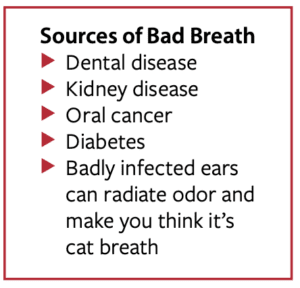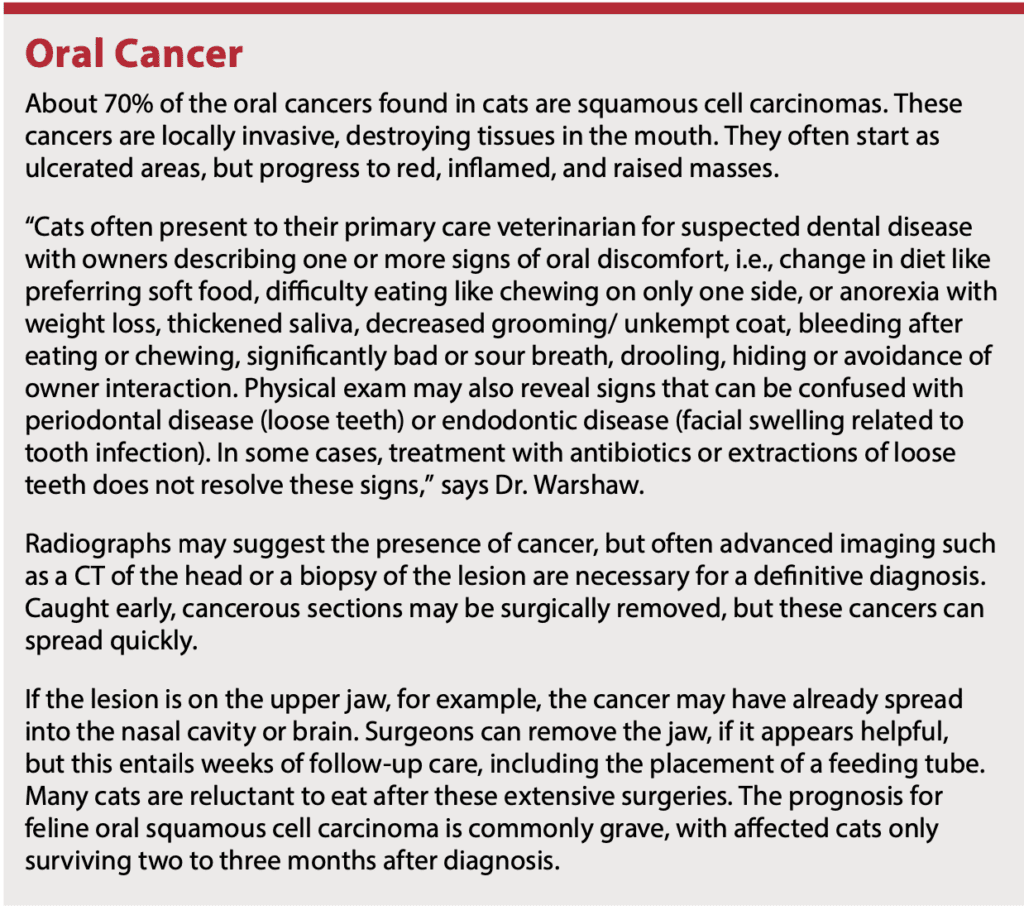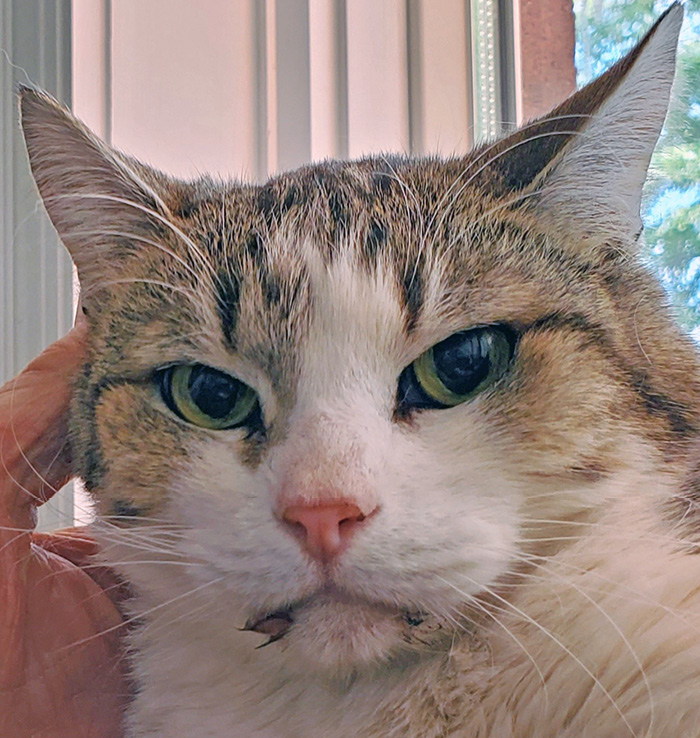If you do an internet search to learn more about your cat’s bad breath and/or teeth, you’ll read a lot about preventing and treating periodontal disease. And that’s obviously critical. What you may not read about, however, is the danger of bacteria from those bad teeth and gums. These bacteria can, in some cases, migrate to others part of the body, causing heart, liver, and kidney disease. It’s important that all cat owners understand this risk.
Periodontal Disease
Over 85% of cats over 6 years old have periodontal disease—infection/inflammation of the gums—or worse. Sadly, many cats show signs of periodontal disease relatively early in their lives, but few owners regularly look at their cat’s teeth. It’s not easy to do, after all.
 Signs of feline dental disease vary from subtle to severe. Excessive drooling, bad breath, dropping food while eating, turning the head to the side while eating, and not wanting to eat at all—especially if a cat turns away from dry food but eats canned food—can be signs of oral problems. A cat with dental pain may attempt to eat or drink and walk away or sit near the food without touching it.
Signs of feline dental disease vary from subtle to severe. Excessive drooling, bad breath, dropping food while eating, turning the head to the side while eating, and not wanting to eat at all—especially if a cat turns away from dry food but eats canned food—can be signs of oral problems. A cat with dental pain may attempt to eat or drink and walk away or sit near the food without touching it.
If you look, you may notice that the cat’s gums are red and inflamed. Teeth may have an obvious buildup of tartar and plaque. You may notice some blood in your cat’s saliva or even find a tooth on the floor. These clinical signs should spark a visit to your veterinarian.
The Veterinary Exam
Many cats do not cooperate with a veterinarian’s attempt to do an oral exam, especially if their mouth is painful, so sedation or even general anesthesia may be required. The veterinarian will likely order blood tests to rule out kidney or liver disease and other problems that might be at work as well.
Dental radiographs can help the veterinarian determine the depth of the oral disease. Your  veterinarian will look for signs of gingivostomatitis, tooth resorption, oral cancer, broken teeth, and ulcers. If the findings are severe, you may be referred to a dental specialist.
veterinarian will look for signs of gingivostomatitis, tooth resorption, oral cancer, broken teeth, and ulcers. If the findings are severe, you may be referred to a dental specialist.
Professional Clean Up
Some owners attempt to scale their cat’s teeth themselves, removing obvious tartar and plaque. While removing large pieces of plaque and tartar is an improvement, it’s usually short lived. Without a thorough cleaning and polishing, both will return very quickly. Plus, you cannot address debris just below the gum line at home.
Dental procedures can be painful. Your cat may receive nerve blocks while under anesthesia to provide pain relief and/or you may be sent home with pain medications. Follow the directions exactly if you are sent home with medicine. Cats are sensitive to many pain medications, and you don’t want to overdose your cat. You will also have instructions about feeding your cat to minimize discomfort.
“Once appropriate diagnostics and treatment are performed, then other forms of at-home oral care can be instituted, which may include water additives, dental chews or treats, or veterinary formulated diets. It is critical to understand that to get the most benefit from these products, it is recommended that these products be used following professional oral care,” says Sydney Warshaw DVM, dental resident at Cornell University’s College of Veterinary Medicine.
Staying Clean
The gold standard for keeping a cat’s teeth healthy is daily brushing. If that’s not possible, at least a couple of times a week may suffice. Start right away, when the cat is young, if possible. Start with gently massaging the outside of the cat’s muzzle followed by a high-value treat. Some cats will also lick cat-approved—never human!—toothpaste off of your finger (poultry and seafood are favorite flavors). Then over time, move to gently lifting the lip to visualize the teeth and touch or massage the gums with a fingertip, until finally introducing a soft-bristled toothbrush. You may need an intermediate step of simply slipping your toothpaste-coated finger under her lip.
While the movement of the brush helps, it’s really the enzymes in the pet toothpaste that help loosen and remove plaque, which will turn to that rock-hard tartar if not removed. Follow the cat’ s daily dental care with a high-value treat like a bit of baked chicken.
“If you are frustrated with at-home oral care, then your cat is mostly likely frustrated as well. If your cat runs away, hides, hisses, bites, scratches, etc., then it is not worth stressing them or you out. Stressed cats would benefit most from anesthetized exams with their regular veterinarian,” says Dr. Warshaw.
Beyond Brushing
Dental water additives that are on the Veterinary Oral Health Council (VOHC) recommended products list (see sidebar) contain soluble salts that reduce bad breath or chlorhexidine that can reduce bacterial load in the mouth. These products can sometimes alter the taste of water, so bowls of fresh water should also be available. Be sure to verify that your cat is drinking.
While treats, biscuits, and chews may seem like an easier option, they won’t do a thing if your cat just quickly consumes them. “Many of these products are coated with some enzyme or medication that acts to prevent calcification of plaque or disrupt pathways that lead to plaque or calculus development. Efficacy of these depends on time spent chewing the product and the teeth used to chew the product. For example, if your pet does not chew the treat, but gulps it instead, then they are not receiving its benefit,” says Dr. Warshaw.
Dental Diets
Dental diets may be a better choice for these cats. Dry food alone does not improve oral health, as the pieces are often small enough that some cats may not chew them at all. Dental diets work by virtue of their additives and textural characteristics, such as fiber content, kibble size, and shape. Dental kibbles, which tend to be larger than regular kibble, are specially designed to be chewed, not gulped, and not to shatter when engaged by the crown of the tooth, allowing the entire crown of the tooth to penetrate the kibble, promoting maximal contact of tooth to the product.

Unless your cat has a food allergy or systemic disease that requires a specific diet, you can feed moist and/or dry food, whatever the cat prefers. Surprisingly enough, there are many cats without teeth that love to crunch on hard kibbles. So, feed what your cat prefers, and see if you can coax your cat into tolerating regular brushing with an enzymatic cat-approved toothpaste.
To ensure your cat’s optimal comfort, health, and longevity, good dental care is critical, regardless of a cat’s age. It needs to start as soon as you get your cat and continue throughout her life. Remember that feline oral health is a window to her overall health.




